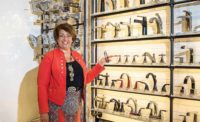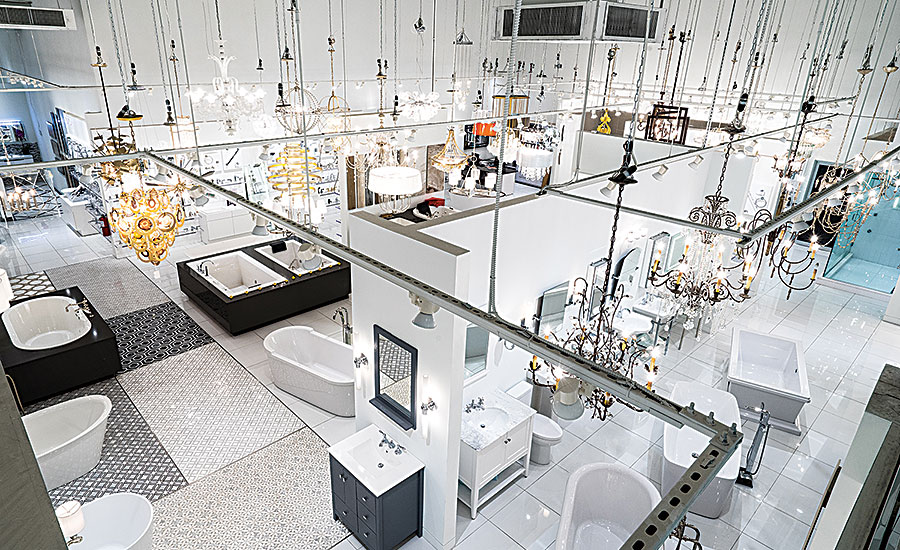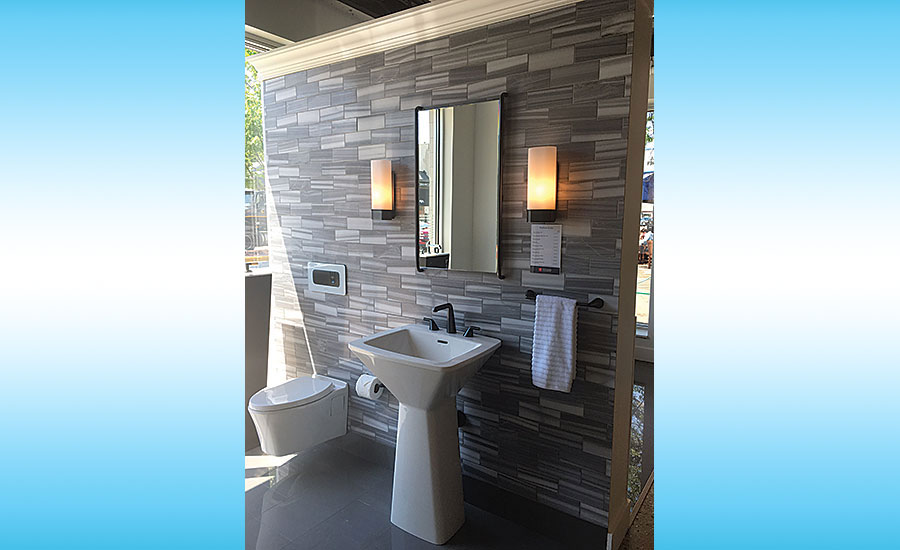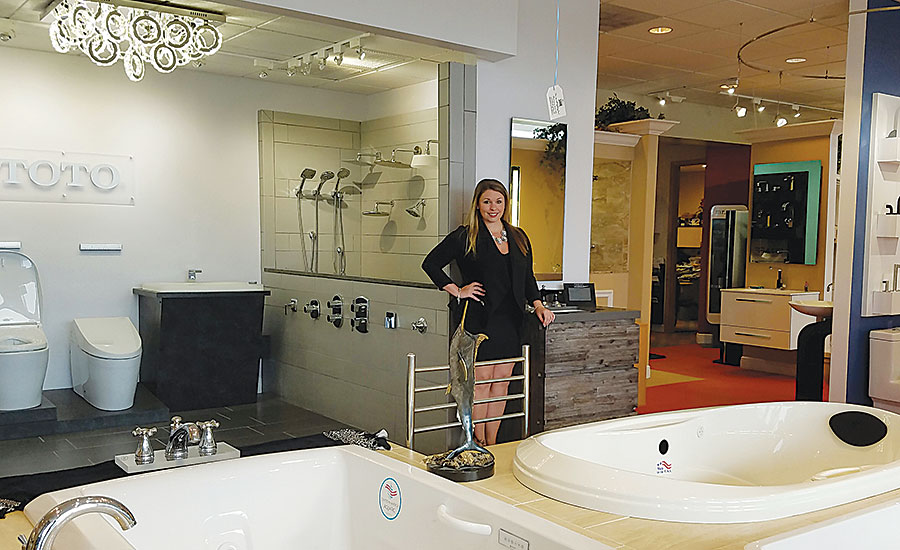Bath and kitchen showroom experts speak out
The ever-changing landscape of showrooms.

New York-based Blackman Plumbing Supply continues to evolve in the marketplace by adding new products. “We recently have joined the lighting, tile, stone and outdoor living industries, allowing us to stabilize margins in this increasingly competitive market,” Blackman’s David Lyon says. Photo courtesy of Blackman Plumbing Supply.

Gerhard’s recently celebrated its grand opening. Piper says the industry’s labor shortage is being felt at the showroom level. Photo courtesy of First Supply.

Jessica Schussler, showroom manager at the Kitchen & Bath Design Studio in Miami, says Internet pricing continues to be a front-of-mind topic. “It’s, by far, our biggest challenge in the industry today,” she says. Photo courtesy of Jessica Schussler.



The constant influx of new technology isn’t showing any signs of slowing down when it comes to kitchen and bath showrooms.
That is one of many trends a group of showroom experts cite when talking about the current business climate in their facilities.
“Consumers are comfortable with technology so they are looking for tools such as digital valves and products connected to their devices,” says Jennifer Piper, Eastern district sales and operations manager — kitchen and bath stores at Gerhard’s (a division of Wisconsin-based First Supply). “They want things that are convenient to use and the innovation that makes everyday tasks easier. Products such as message centers in kitchen cabinetry and power-charging stations that pop up from counter tops are very popular.”
Tonya Martinof South Carolina-based ProSource Plumbing Supply says the constant envelope-pushing of technology applies to a showroom’s consultant staff as well. “Showrooms will need to evolve as the market continues to change,” she says. “I see more technology being used during consultations. I also see showrooms finding more ways to having the customers be able to visualize their actual bath in a real-life setting. The technology is not there yet. I am being a little ‘Jetson’ in thinking, but I could even see customers bring in their tile selections, paint samples and countertop selections to a virtual room where we create their bath or kitchen and they could see it all come together.”
Water conversation truths
Most showroom experts who participated in this story say water conservation rarely is part of the conversation these days when customers select products.
“Water conservation is very rarely considered by our customers,” says Jimmy Georgitsos, of Ottawa, Ontario, Canada-based Astro Design Centre. “People are removing water restrictors and we find many customers wanting to confirm fixtures are not low-flow.”
Denise Champagneof Beaumont, Texas-based Coburn Supply says education comes into play when talking about low-flow fixtures. “When consumers are buying product in our showroom water conservation isn’t the main reason they purchase product,” she says. “In fact, sometimes it is looked down upon in their minds because of what they are used to, such as replacing a toilet that was 3.5 gpf to the now federal plumbing standards of 1.6 or even 1.28 in some of our areas. However, after showing them the newest technologies and how much water they do save, it’s a mindset change and they appreciate the education and time our showroom consultants spend with them.”
Audrey Loderof North Carolina-based Wilkinson Supply says water quality has been a bigger topic of conversation of late. “Our clients tend to stay conservative with their water usage,” she says. “We are fortunate to work with manufacturers whose technology is capable of performing at a high level with less water. Customers want to see a toilet with a slick design, a clean toilet bowl and a 1-gal. flush. They want to get a powerful spray from a showerhead or hand shower at less than 2 gpm.”
Causes for concern
Not shockingly, Internet pricing remains a topic of great concern for showroom operators around North America. “It’s by far our biggest challenge in the industry today,” says Jessica Schussler, showroom manager at Miami-based Kitchen & Bath Design Studio (a division of Lion Plumbing Supply). “Everyone wants to shop online and complete their renovations from the comfort of their couch. We are working hard to keep up. We are in the process of rebranding our showroom and we have a new website coming that will be mobile friendly and allow for customers and the rest of the Internet to shop at home and still have access to our wholesale pricing and experienced showroom personnel.”
Jayme Adams, showroom director at Expressions Home Gallery (a Morsco company), adds with the continued proliferation of the Internet, making sure showroom consultants stay ahead of cutting-edge trends and products is a must. “Making sure this happens increases our value with the customer and ultimately makes for a successful showroom,” she says.
Mary Wrightof Indianapolis-based HomeStyle Showrooms (a division of Economy Plumbing Supply) agrees that sales staffs must be in constant education mode in today’s setting. “The awareness of Internet competition is going to be a much bigger game-changer,” she says. “Sales staffs will have to be on top of their game regarding products and the differences why our products have a greater value than the off-brand products that look desirable on the Internet.”
David Hawkins, principal of Akron, Ohio-based David L. Hawkins Design, stresses showrooms must develop a retail-oriented mindset in today’s competitive marketplace. “In my 30 years of working with kitchen and bath showrooms, I have seen companies exist almost exclusively on wholesale business,” he says. “I have witnessed extreme loyalty to the contractor sales part of the business and rightfully so. You never want to bite the hand that feeds you. However, the retail potential of each store adds a whole new dimension. In order for an increase to occur, the showroom must see beyond the contractor and develop a retail mentality. Change is inevitable and causes discomfort. As the customer base evolves and grows, showrooms need to adapt or be left behind. This has been a personal nemesis for most of my career.”
Piper says the much-talked-about labor shortage in the industry also is a cause for alarm with showrooms. “There is a shortage of labor to install products,” she says. “We already see our best customers booked months out and fewer young people coming into the industry. We as distributors need to partner with our vendors to support trade programs and raise the reputation of the industry. We know it’s an industry that is indispensable to the safety and longevity of our nation and the world, but we need to spread the message.”
The crystal ball
Despite a variety of different daily challenges, showroom operators are strong in their opinions that the brick-and-mortar concept isn’t going anywhere anytime soon.
“The showroom business will continue to grow and prosper the next few years,” says David Lyon, vice president of retail and creative director at New York-based Blackman Plumbing Supply. “Consumers are becoming better informed and smarter shoppers who want to experience the touch, feel and look of our industry’s products within a comfortable and inspirational shopping environment.”
Martin notes there always will be a place for plumbing showrooms. “The showroom allows more physical senses to be used with the buying process that the Internet will never be able to provide,” she says. “The touch sense as well as visually seeing the product cannot be reproduced online.”
Georgitsos adds: “People always want to see and try product in person before they purchase. These are big and important purchases and having our designers as salespeople allows customers to gain a better and more knowledgeable buying experience than they would online.”
In line with Hawkins’ earlier thoughts, showroom experts agree in order to continue to thrive, change must continue to be embraced. “Convenience and relevance will be paramount,” Piper says. “We need to be located in visible locations that consumers and tradespeople alike are comfortable visiting. We need to have hours that allow them to choose our businesses over big boxes and the Internet. We need to have displays and store layouts that allow customers to quickly and confidently make decisions.”
Schussler adds: “The key is to keep up with the times, stay informed and be ready to embrace the change.”
This article was originally titled “Ever-changing landscape” in the July 2016 print edition of Supply House Times.
Looking for a reprint of this article?
From high-res PDFs to custom plaques, order your copy today!









